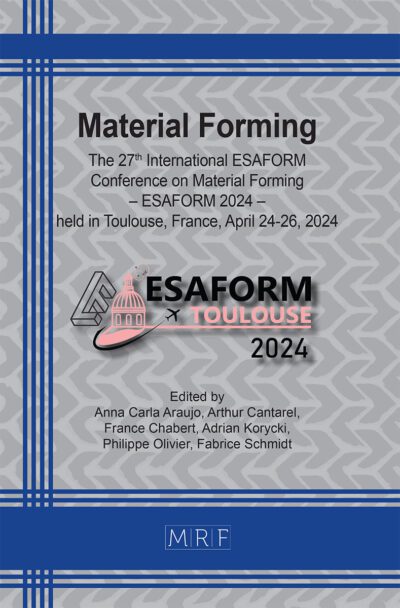Thermodynamic model using Kelvin decomposition to predict the mechanical behaviour of single-crystal superalloys after casting operation
Louis ROCHE, Carl LABERGERE, Houssem BADREDDINE, Mylène LEDUC, Taha Niane NGADIA
Abstract. The manufacturing of single crystal nickel-based superalloys components, such as turbine blades, using the lost-wax casting method is a complex process that can generate various defects. Among them, the recrystallisation defect, which is the focus of this study, occurs during solidification. This defect is characterised by the formation of highly misoriented grains, leading to a significant degradation of mechanical properties. The formation of these grains is partly attributed to the introduction of plastic strain in the alloy during cooling, caused by the difference in thermal expansion of the various components of the mould (shell and core), as well as subsequent heat treatments. To predict the mechanical state of the component at the end of cooling, a macroscopic thermo-elastoviscoplastic model has been developed. The mechanical state prediction, using recrystallisation criteria established by Safran, provides a visual indicator of areas susceptible to recrystallise. In this paper, the inherent cubic orthotropy of FCC single-crystal superalloys is introduced through Kelvin spectral decomposition of the Hooke elasticity tensor. Considering orthotropy will enable better simulation of the blade’s behaviour, particularly for hollow blades, whose load paths are more complex due to the presence of a core. The stress tensor is also decomposed in three Kelvin modes which are then used to formulate a yield criterion extended to viscoplasticity. The proposed model is based on two viscoplastic criterion functions designed to represent the different octahedral and cubic slip systems, like the crystal plasticity models commonly used to model these alloys.
Keywords
Single Crystal Ni-Based Superalloys, Anisotropy, Kelvin Decomposition
Published online 5/7/2025, 9 pages
Copyright © 2025 by the author(s)
Published under license by Materials Research Forum LLC., Millersville PA, USA
Citation: Louis ROCHE, Carl LABERGERE, Houssem BADREDDINE, Mylène LEDUC, Taha Niane NGADIA, Thermodynamic model using Kelvin decomposition to predict the mechanical behaviour of single-crystal superalloys after casting operation, Materials Research Proceedings, Vol. 54, pp 1910-1918, 2025
DOI: https://doi.org/10.21741/9781644903599-205
The article was published as article 205 of the book Material Forming
![]() Content from this work may be used under the terms of the Creative Commons Attribution 3.0 license. Any further distribution of this work must maintain attribution to the author(s) and the title of the work, journal citation and DOI.
Content from this work may be used under the terms of the Creative Commons Attribution 3.0 license. Any further distribution of this work must maintain attribution to the author(s) and the title of the work, journal citation and DOI.
References
[1] C. Labergère, M. Long, H. Badreddine, N-T. Niane, D. Grange, K. Saanouni, Thermomechanical model for solidification and cooling simulation of Ni-based superalloy components. International Journal of Solids and Structures 212 (2021). https://doi.org/10.1016/j.ijsolstr.2020.12.009
[2] M. Long, N. Leriche, H. Badreddine, N-T. Niane, D. Grange, C. Labergère, A new experimental and simulation methodology for prediction of recrystallisation in Ni-based. Journal of Materials Processing Tech. 306 (2022). https://doi.org/10.1016/j.jmatprotec.2022.117624
[3] B. Fedelich, A microstructural model for the monotonic and the cyclic mechanical behavior of single crystals of superalloys at high temperatures. International Journal of Plasticity 18 (2002). https://doi.org/10.1016/S0749-6419(00)00045-0
[4] Nouailhas, D. & Cailletaud, G, Tension-Torsion behavior of single crystal superalloys experiment and finite element analysis. International Journal of Plasticity 11 (1995). https://doi.org/10.1016/S0749-6419(98)80004-1
[5] Thomson (Lord Kelvin), W.K., 1856. Elements of a mathematical theory of elasticity. Philos. Trans. Roy. Soc. 166, 481.
[6] R. Desmorat, R. Marull, Non-quadratic Kelvin modes-based plasticity criteria for anisotropic materials. International Journal of Plasticity 27 (2011). https://doi.org/10.1016/j.ijplas.2010.06.003
[7] R. Desmorat, A. Mattiello, J. Cormier, A tensorial thermodynamic framework to account for the γ’ rafting in Nickel-based single crystal superalloys. International Journal of Plasticity 95 (2017). https://doi.org/10.1016/j.ijplas.2017.03.010
[8] N. Marchal, Propagation de fissures en fatigue-fluage à haute température de superalliages monocristallins à base de nickel. Ecole Nationale Supérieure des Mines de Paris Ph.D. (2006)












